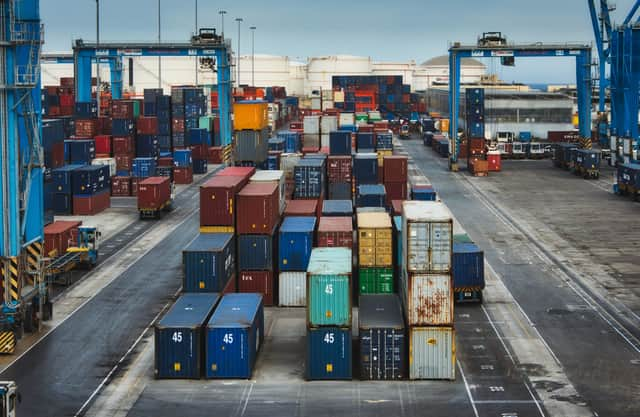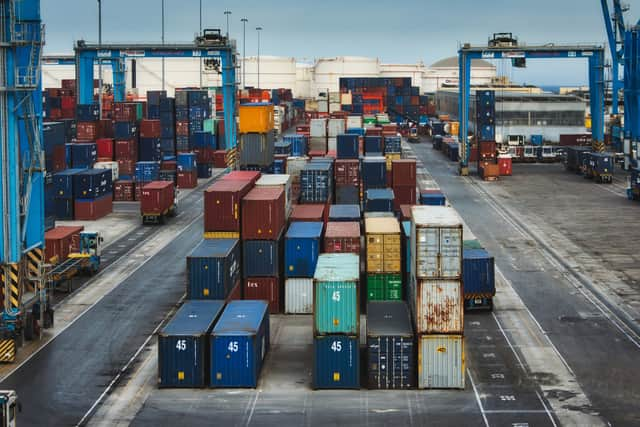Glasgow green freeport: Bid to create 30,000 new jobs submitted


The freeport proposal could attract £2.5 billion of capital investment and transform nearly 600 hectares of vacant and derelict land in key locations.
The bid for Clyde Green Freeport would generate a multi-billion pound boost for the Glasgow City Region economy and accelerate regional, national and UK net zero targets.
Advertisement
Hide AdAdvertisement
Hide AdThe formal bid has been submitted to the Scottish and UK governments by a partnership of Glasgow Airport, Peel Ports’ Clydeport, Mossend International Railfreight Park in North Lanarkshire and Glasgow City Region councils.
The bid has already attracted support from many key businesses and organisations based or operating within Glasgow City Region including Caterpillar, Malcolm Group, SP Energy Networks, the Universities of Glasgow and Strathclyde, Morrison Construction and Loganair.


A green freeport is a large, zoned area within a defined boundary which includes a rail, sea or airport. Operators and businesses in the zone can benefit from a package of tax and other incentives.
“Our bid is multimodal, covering air, sea and rail, and will further unlock global trade, doubling capacity to take products from across Scotland to the rest of the UK, Europe and beyond,” said Kevin Rush, Clyde Green Freeport Bid senior responsible officer and director of regional economic growth for Glasgow City Region.
Advertisement
Hide AdAdvertisement
Hide Ad“It will provide an £18 billion uplift in GVA to 2034. Vitally it will tackle the region’s greatest economic challenges - increasing productivity and generating more inclusive growth. This will be achieved through fast-tracking our world-class innovation economy and creating tens of thousands of jobs in communities across the Region with high levels of deprivation. Almost 40% of Scotland’s most deprived communities are within the Clyde Green Freeport area.
“With the biggest city deal in the UK and the legacy of COP26, Glasgow City Region has a proven track record of delivery. As Scotland’s economic powerhouse, with unrivalled connectivity across the UK and beyond, we have everything in place to deliver a globally successful green freeport for our region, our residents, businesses, Scotland and the UK.”
Key to the Clyde Green Freeport bid is a bold decarbonisation plan which would accelerate the Scottish and UK Governments’ net zero ambitions.
The Clyde Green Freeport would achieve net zero by 2040, and would include a new district heating system; waste to energy projects; renewable energy generation and projects to roll out green fuel for air, rail, road and sea transport within industries which have been dominated by carbon - including a new £1 billion hydrogen plant which could fuel 25% of Scotland’s HGVs.
Plans for the air
Advertisement
Hide AdAdvertisement
Hide AdThe world’s first climate neutral airport cluster would be created at Glasgow Airport and the Advanced Manufacturing Innovation District Scotland (AMIDS) in Renfrewshire through plans for a solar park, district heating network, electric vehicle fleet and a multi-fuel hub. Clyde Green Freeport presents a fantastic opportunity to propel the Scottish aerospace sector towards a leading role in delivering Jet Zero air travel decarbonisation and an increased share of the additional £39 billion and 150,000 jobs associated with it.
The 185-hectare cluster includes the airport and AMIDS and is an established employment, innovation and connectivity hub which will be boosted by the opening of the National Manufacturing Institute Scotland (NMIS) and Medicines Manufacturing Innovation Centre. It will be a focus for aerospace, advanced manufacturing and life sciences sectors – all of which are high-skill, high value and export orientated – complementing major existing businesses including Boeing, Loganair, British Airways Maintenance, Thermo Fisher and Doosan Babcock.
A new state of the art cargo facility will double cargo handling capacity, enabling the airport to increase the value of Scottish exports beyond the 25% it currently handles and making a vital contribution to meeting the UK and Scottish targets of hitting £1 trillion in exports annually and growing the share of GDP generated by exports to 25% respectively.
Plans for rail
Mossend in North Lanarkshire is home to a major rail freight hub and rail terminal. Clyde Green Freeport would see regeneration of 283 hectares of land through £17 million of investment unlocked by tax benefits and, in the longer term, £300 million to develop the site and create the infrastructure needed.
Advertisement
Hide AdAdvertisement
Hide AdA new £44 million high capacity, decarbonised rail interchange would be developed with eight 775m rail sidings served by two electric gantry cranes, electric rail shunters, cross docking facilities and associated road and rail access infrastructure. In addition, there will be a net zero freight park consisting of 2.1 million square feet of manufacturing and logistics buildings and associated facilities.
This would meet the increasing demand for exports for all of Scotland and support modal shift from road to rail, saving 225,000 tonnes of carbon annually.
It would also create an opportunity for a manufacturing heavy vehicles hub, leading to £120 million of investment and over 500 jobs, as well as for the manufacturing, maintenance and operation of new innovative freight wagons, with an estimated £55 million of investment.
Plans for the sea
Greenock deep ocean terminal would double its capacity, with more than £16 million of investment, to allow a modal shift from the 27,000 trucks which travel north to south annually as part of a bold port decarbonisation programme. This will unlock decarbonised global trade for businesses across Scotland and deliver the net zero target by 2040.
Advertisement
Hide AdAdvertisement
Hide AdThere will be investment in electric cranes and straddle carriers, new low carbon marine fuel bunkering capability to support green fleets, and low carbon heating using ground source and river source technologies.
And an enhanced logistics management system will improve efficiency in vehicle movement, saving fuel and time and improving air quality.
In Inverclyde regeneration of 85 hectares of land along the River Clyde, enabled by tax site benefits, would generate £36 million of new investment to upgrade, reclaim and regenerate land that would otherwise not be commercially viable.
Upgrading and replacing legacy infrastructure will generate a hub for direct sea access, for business including sea-food processing, expansion of on-shore turbine operation in KGV, salt, cement and recycling facilities, and the drinks industry.
Comment Guidelines
National World encourages reader discussion on our stories. User feedback, insights and back-and-forth exchanges add a rich layer of context to reporting. Please review our Community Guidelines before commenting.
